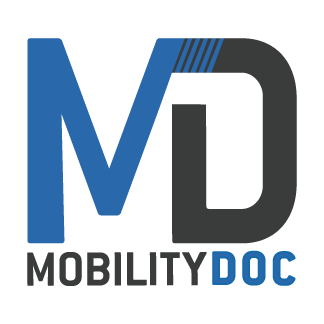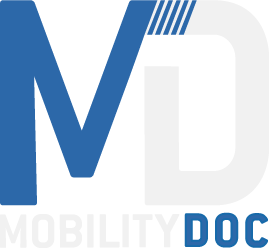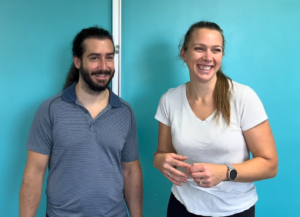As we progress through our four-part yoga series for runners, we’ve arrived at week three, where we’ll tackle the iconic Down Dog pose. This foundational asana is a game-changer for runners, as it targets key areas that can significantly improve your running performance and prevent injuries. Let’s deepen our understanding of how important big toe flexibility is and why this yoga pose for runners is one of our favorites!
The Importance of Down Dog for Runners
Running puts lots of stress on your feet, hamstrings, and calves. Over time, these areas can become tight and inflexible, leading to inefficient stride mechanics and an increased risk of injury. To counter all the tightness through the posterior chain, we will practice down dog.
By practicing Down Dog, you’ll be actively stretching and lengthening the muscles in your feet, hamstrings, and calves. This increased flexibility translates to improved propulsion and push-off during your runs. Not just that, you’ll make sure you’re able to activate that glute (more on that later)! When these areas are mobile, you’ll be able to generate more power with each stride, leading to a more efficient and enjoyable running experience.
The Toe-Out Tendency
One common issue that runners face is a lack of big toe flexibility. Why is this important? You need 55 degrees of toe extension to be able to activate your glute. Crazy right?! When the big toe is restricted, runners often compensate by turning their feet outward during their stride. This toe-out position can lead to imbalances and potential injuries in the knees, hips, and lower back.

By incorporating week 3’s mobility exercises into your routine, you’ll be actively working on improving the mobility and flexibility of your big toes in each exercise. As you progress, you’ll notice a greater ability to keep your feet aligned and pointed forward, reducing the risk of compensatory movements and potential injuries.
Down Dog
Throughout our practice, we’ll use Down Dog as both a pre-test and a post-test, allowing you to gauge your progress and witness the improvements in your mobility firsthand. We want to approach down dog to get the most out of it. How we like to get into it is by:
- Start on your hands and knees with your hands stacked under your shoulders, feet hip width apart.
- Tuck your toes under and hover your knees above the ground.
- Push your hips back while keeping your knees bent
- Lastly extend through your knees dropping your heels towards the ground
- You should now be in an A frame/triangle shape hinging at your hips. You should feel a slight arch in your low back while keeping your shoulders away from your ears as you press through your hands.

You want to hold here for 30-60 seconds. Pay attention to how your hips, hamstrings, calves, and feet all feel while you’re in this position.
The Down Dog Mobility Routine
To maximize the benefits of Down Dog, we’ll be incorporating three targeted exercises into our routine:
Supine Dynamic Hamstring Stretch


This exercise will help loosen up your hamstrings, preparing them for the deep stretch of Down Dog. The best part about doing this on your back is that it gives you more practical awareness of a few different body factors. It’s important to keep a slight arch in your back for proper stretching of your hamstrings. Being on your back makes it much easier to feel this. It’s also important to push evenly through both sides of the foot while keeping your toes straight.
Single Leg Down Dog
By isolating each leg in the Down Dog position, you’ll be able to focus on improving mobility and flexibility in each individual hamstring and calf. You’ll be able to tease out differences between one side and then the other. This is important for understanding your asymmetries and what your body needs more of!

Kneeling Toe Stretch

This exercise will directly target the flexibility of your toes, ensuring that you can fully engage and utilize them during your runs. Some of our patients call this the toe breaker! It can be incredibly intense if you’re not used to it and have stiffness here. Make sure your big toes are facing straight forward and your heels aren’t falling to the outside to compensate.
Watch Our Follow Along Yoga For Runners Video For Detailed Explanations of Each Exercise!
How To Use This Series
How are we using this 4 part series? As runners looking to improve our own form and optimize performance, we are taking each week and incorporating it into 1 post run cool down. That means we rotate the different yoga for runners mobility videos after every run. Let us know which one your favorite is! Tag us on any of our social media accounts with your progress and how these are changing your running form!
Stay tuned for our next installment, where we’ll explore another essential yoga pose for runners. Until then, embrace the power of Down Dog, and enjoy the journey towards better mobility, efficiency, and injury prevention.
There's an MDRx For That!
What’s MDRx you ask? It’s a 4 week systematic program to get you back to 100%. Whether you have a nagging tweak, just finished PT and aren’t quite where you want to be, or simply looking for some upkeep, MDRx programs target your flexibility, stability, and strength of the body region you need help with. Say goodbye to your nagging twinges. Start Your Program Today!






